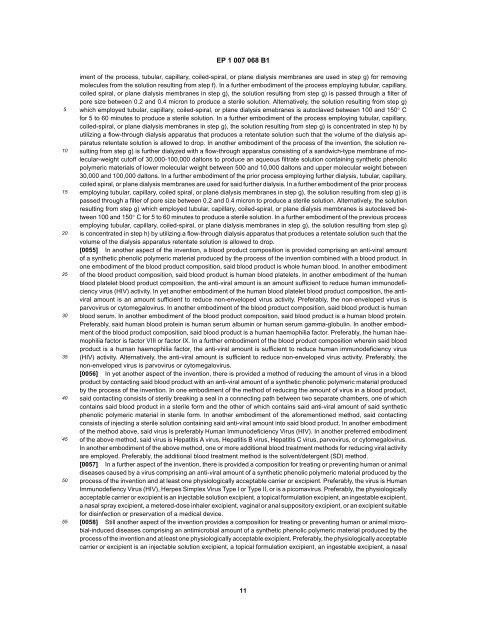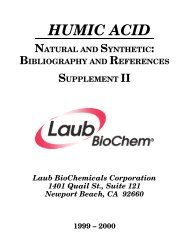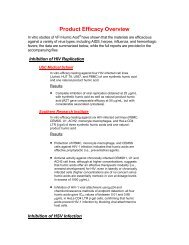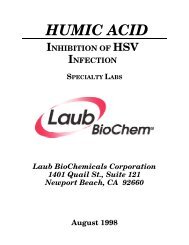HUMIC ACID - Laub BioChem
HUMIC ACID - Laub BioChem
HUMIC ACID - Laub BioChem
- No tags were found...
Create successful ePaper yourself
Turn your PDF publications into a flip-book with our unique Google optimized e-Paper software.
EP 1 007 068 B1510152025303540455055iment of the process, tubular, capillary, coiled-spiral, or plane dialysis membranes are used in step g) for removingmolecules from the solution resulting from step f). In a further embodiment of the process employing tubular, capillary,coiled spiral, or plane dialysis membranes in step g), the solution resulting from step g) is passed through a filter ofpore size between 0.2 and 0.4 micron to produce a sterile solution. Alternatively, the solution resulting from step g)which employed tubular, capillary, coiled-spiral, or plane dialysis emebranes is autoclaved between 100 and 150° Cfor 5 to 60 minutes to produce a sterile solution. In a further embodiment of the process employing tubular, capillary,coiled-spiral, or plane dialysis membranes in step g), the solution resulting from step g) is concentrated in step h) byutilizing a flow-through dialysis apparatus that produces a retentate solution such that the volume of the dialysis apparatusretentate solution is allowed to drop. In another embodiment of the process of the invention, the solution resultingfrom step g) is further dialyzed with a flow-through apparatus consisting of a sandwich-type membrane of molecular-weightcutoff of 30,000-100,000 daltons to produce an aqueous filtrate solution containing synthetic phenolicpolymeric materials of lower molecular weight between 500 and 10,000 daltons and upper molecular weight between30,000 and 100,000 daltons. In a further embodiment of the prior process employing further dialysis, tubular, capillary,coiled spiral, or plane dialysis membranes are used for said further dialysis. In a further embodiment of the prior processemploying tubular, capillary, coiled spiral, or plane dialysis membranes in step g), the solution resulting from step g) ispassed through a filter of pore size between 0.2 and 0.4 micron to produce a sterile solution. Alternatively, the solutionresulting from step g) which employed tubular, capillary, coiled-spiral, or plane dialysis membranes is autoclaved between100 and 150° Cfor 5 to 60 minutes to produce a sterile solution. In a further embodiment of the previous processemploying tubular, capillary, coiled-spiral, or plane dialysis membranes in step g), the solution resulting from step g)is concentrated in step h) by utilizing a flow-through dialysis apparatus that produces a retentate solution such that thevolume of the dialysis apparatus retentate solution is allowed to drop.[0055] In another aspect of the invention, a blood product composition is provided comprising an anti-viral amountof a synthetic phenolic polymeric material produced by the process of the invention combined with a blood product. Inone embodiment of the blood product composition, said blood product is whole human blood. In another embodimentof the blood product composition, said blood product is human blood platelets. In another embodiment of the humanblood platelet blood product composition, the anti-viral amount is an amount sufficient to reduce human immunodeficiencyvirus (HIV) activity. In yet another embodiment of the human blood platelet blood product composition, the antiviralamount is an amount sufficient to reduce non-enveloped virus activity. Preferably, the non-enveloped virus isparvovirus or cytomegalovirus. In another embodiment of the blood product composition, said blood product is humanblood serum. In another embodiment of the blood product composition, said blood product is a human blood protein.Preferably, said human blood protein is human serum albumin or human serum gamma-globulin. In another embodimentof the blood product composition, said blood product is a human haemophilia factor. Preferably, the human haemophiliafactor is factor VIII or factor IX. In a further embodiment of the blood product composition wherein said bloodproduct is a human haemophilia factor, the anti-viral amount is sufficient to reduce human immunodeficiency virus(HIV) activity. Alternatively, the anti-viral amount is sufficient to reduce non-enveloped virus activity. Preferably, thenon-enveloped virus is parvovirus or cytomegalovirus.[0056] In yet another aspect of the invention, there is provided a method of reducing the amount of virus in a bloodproduct by contacting said blood product with an anti-viral amount of a synthetic phenolic polymeric material producedby the process of the invention. In one embodiment of the method of reducing the amount of virus in a blood product,said contacting consists of sterily breaking a seal in a connecting path between two separate chambers, one of whichcontains said blood product in a sterile form and the other of which contains said anti-viral amount of said syntheticphenolic polymeric material in sterile form. In another embodiment of the aforementioned method, said contactingconsists of injecting a sterile solution containing said anti-viral amount into said blood product. In another embodimentof the method above, said virus is preferably Human Immunodeficiency Virus (HIV). In another preferred embodimentof the above method, said virus is Hepatitis A virus, Hepatitis B virus, Hepatitis C virus, parvovirus, or cytomegalovirus.In another embodiment of the above method, one or more additional blood treatment methods for reducing viral activityare employed. Preferably, the additional blood treatment method is the solvent/detergent (SD) method.[0057] In a further aspect of the invention, there is provided a composition for treating or preventing human or animaldiseases caused by a virus comprising an anti-viral amount of a synthetic phenolic polymeric material produced by theprocess of the invention and at least one physiologically acceptable carrier or excipient. Preferably, the virus is HumanImmunodefiency Virus (HIV), Herpes Simplex Virus Type I or Type II, or is a picomavirus. Preferably, the physiologicallyacceptable carrier or excipient is an injectable solution excipient, a topical formulation excipient, an ingestable excipient,a nasal spray excipient, a metered-dose inhaler excipient, vaginal or anal suppository excipient, or an excipient suitablefor disinfection or preservation of a medical device.[0058] Still another aspect of the invention provides a composition for treating or preventing human or animal microbial-induceddiseases comprising an antimicrobial amount of a synthetic phenolic polymeric material produced by theprocess of the invention and at least one physiologically acceptable excipient. Preferably, the physiologically acceptablecarrier or excipient is an injectable solution excipient, a topical formulation excipient, an ingestable excipient, a nasal11










